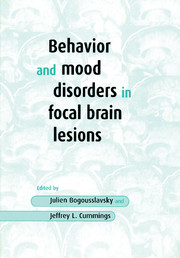Book contents
- Frontmatter
- Dedication
- Contents
- List of contributors
- Preface
- Acknowledgments
- 1 Emotional consequences of focal brain lesions: an overview
- 2 The evaluation of mood and behavior in patients with focal brain lesions
- 3 Methodological issues in studying secondary mood disorders
- 4 Emotional behavior in acute brain lesions
- 5 Depression and lesion location in stroke
- 6 Mood and behavior in disorders of the basal ganglia
- 7 Mania and manic-like disorders
- 8 Behavioral and emotional changes after focal frontal lobe damage
- 9 Disorders of motivation
- 10 Thalamic behavioral syndromes
- 11 Obsessive-compulsive disorders in association with focal brain lesions
- 12 Emotional dysprosody and similar dysfunctions
- 13 Temporal lobe behavioral syndromes
- 14 Neural correlates of violent behavior
- 15 Focal lesions and psychosis
- 16 Alterations in sexual behavior following focal brain injury
- 17 Anosognosia
- 18 Acute confusional states and delirium
- Index
11 - Obsessive-compulsive disorders in association with focal brain lesions
Published online by Cambridge University Press: 05 August 2016
- Frontmatter
- Dedication
- Contents
- List of contributors
- Preface
- Acknowledgments
- 1 Emotional consequences of focal brain lesions: an overview
- 2 The evaluation of mood and behavior in patients with focal brain lesions
- 3 Methodological issues in studying secondary mood disorders
- 4 Emotional behavior in acute brain lesions
- 5 Depression and lesion location in stroke
- 6 Mood and behavior in disorders of the basal ganglia
- 7 Mania and manic-like disorders
- 8 Behavioral and emotional changes after focal frontal lobe damage
- 9 Disorders of motivation
- 10 Thalamic behavioral syndromes
- 11 Obsessive-compulsive disorders in association with focal brain lesions
- 12 Emotional dysprosody and similar dysfunctions
- 13 Temporal lobe behavioral syndromes
- 14 Neural correlates of violent behavior
- 15 Focal lesions and psychosis
- 16 Alterations in sexual behavior following focal brain injury
- 17 Anosognosia
- 18 Acute confusional states and delirium
- Index
Summary
Introduction
In earlier centuries, obsessive-compulsive disorder (OCD) symptomatology was considered to be indicative of demonic possession. Janet (1903) was the first to attempt to describe the phenomenon of OCD without reliance on supernatural forces. Freud saw obsessions as manifestations of repressed sexual and aggressive impulses. Because themes of aggression and dirt or contamination are common in OCD, this led to the speculation that disturbance during the anal sadistic phase plays a role. The conception of a relationship between OCD and cerebral lesions began with the lethargic encephalitis observations from von Economo (1931; see also Jellife, 1929). The anatomical data made it possible to establish the importance of basal ganglia lesions compared to cortical lesions. It was not until much later that this concept was integrated, in particular with the first modern case report of OCD after bipallidal lesions (Laplane et al., 1981).
Since then, more recent studies have suggested a neurological etiology with basal ganglia and frontal lobe pathology as reported in many neuroimaging studies (Baxter et al., 1990; Baxter, 1992; Insel, 1992a) or in cases of acquired obsessivecompulsive disorder (A-OCD). Detailed reports of cases with focal brain lesions may contribute to the understanding of the pathogenesis of OCD.
The aim of this chapter is to describe OCD in association with focal brain lesions, which is one of the best examples of a psychopathological organic disorder that may mimic a classical psychiatric syndrome.
The clinical variants are described first, and then the different etiologies and anatomic correlates that relate them to the functional physiopathology. The final part of the chapter deals with therapeutic issues.
Clinical aspects
Obsessive-compulsive disorder encompasses a broad range of symptoms that include various intrusive thoughts, preoccupations, rituals, and diverse motor behaviors. A definition of OCD was given by the DSM IV (American Psychiatric Association, 1994):
Obsessions are recurrent and persistent thoughts, impulses or images that are experienced, as intrusive and inappropriate and that cause marked anxiety or distress. The person attempts to ignore, suppress or neutralize them with some other thought or action. Compulsions are repetitive behaviors or mental acts that the person feels driven to perform in response to an obsession, or according to rules that must be applied rigidly. The behaviors or mental acts are aimed at preventing or reducing distress.
- Type
- Chapter
- Information
- Behavior and Mood Disorders in Focal Brain Lesions , pp. 304 - 326Publisher: Cambridge University PressPrint publication year: 2000
- 1
- Cited by



